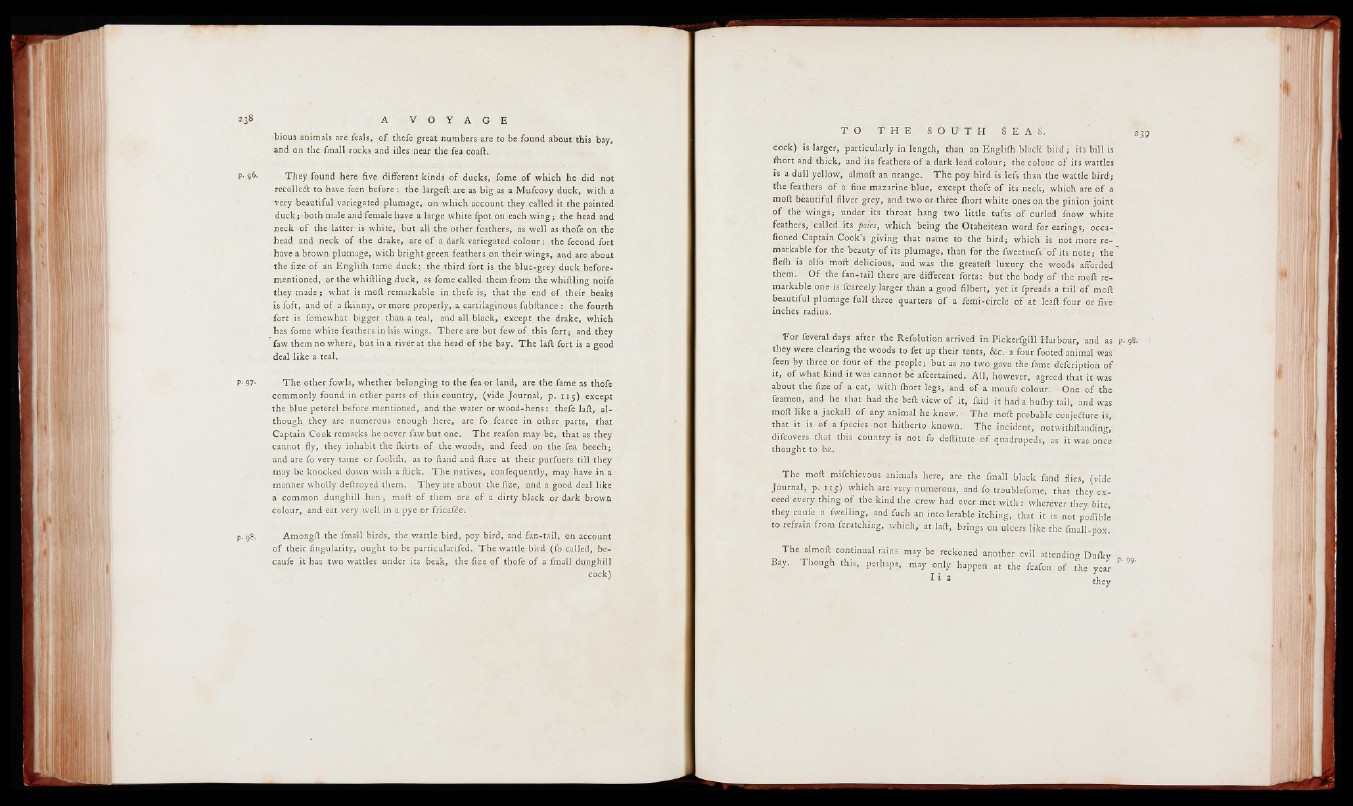
bious animals are feals, of thefe great numbers are to be found about this bay,
and on the fmall rocks and iiles near the fea coail.
p. 96. They found here five different kinds of ducks, fome of which he did not
recolledl to have feen before: the largeft are as big as a Mufcovy duck, with a
very beautiful variegated plumage, on which account they called it,the painted
duck; -both male and female have a large white fpot on each wing; the head and
neck of the latter is white, but all the other feathers, as well as thofe on the
head and neck of the drake, are of a dark variegated colour: the fecond fort
have a brown plumage, with bright green feathers, on their wings, and are about
the fize of an Engliih tame duck: the third fort is the blue-grey duck before-
mentioned, or the whittling duck, as fome called them from the whiftling noife
they made; what is moil remarkable in thefe is, that the end of their beaks
is foft, and of a ikinny, or more properly, a cartilaginous fubftance : the fourth
fort is fomewhat bigger than a teal, and all black, except the drake, which
has fome white feathers in his wings. There are but few of this fort; and they
faw them no where, but in a river at the head of the bay. The lafl fort is a good
deal like a teal.
P- 97* The other fowls, whether belonging to the fea or land, are the fame as thofe
commonly found in other parts o f this country, (vide Journal, p. 115) except
the blue peterel before mentioned, and the water or wood-hens: thefe laft, although
they are- numerous enough here, are fo fcarce in other parts, that
Captain Cook remarks he never faw but one. The reafon may be, that as they
cannot fly, they inhabit the ikirts of the woods, and feed on the fea beech;
and are fo very tame or fooliih, as to (land and Hare at their purfuers till they
may be knocked down with a flick. The natives, confequently, may have in a
manner wholly deilroyed them. They are about the fize, and a good deal like
a common dunghill hen; moil of them are of a dirty black or dark brown
colour, and eat very well in a pye or fricafee.
p. 98. Amongft the fmall birds, the wattle bird, poy bird, and fan-tail, on account
o f their Angularity, ought to be particularifed. The wattle bird (fo called, , be-
caufe it has two wattles under its beak, the fize of thofe of a fmall dunghill
cock)
cock) is larger, particularly in length, than an Engliih black bird; its bill is
fhort and thick, and its feathers of a dark lead colour; the colour of its wattles
is a dull yellow, almoil an orange. The poy bird is lefs than the wattle bird;
the feathers of a fine mazarine blue, except thofe of its neck, which are o f a
moil beautiful filver grey, and two o r three ihort white ones on the pinion joint
o f the wings; under its throat hang two little tufts o f curled fnow white
feathers, called its poles, which being the Otaheitean word for earings, occa-
fioned Captain Cook's giving that name to the bird; which is not more remarkable
for the beauty of its plumage, than for the fweetnefs'of its note; the
fleih is alfo moll delicious, and was the greateft luxury the woods afforded
them. O f the fan-tail there ¿are different forts: but the body of the moil remarkable
one is fcarcely larger than a good filbert, yet it ipreads a tail of moil
beautiful plumage full three quarters of a femi-circle of at leail four or five
inches radius.
For feveral days after the Refolution arrived in Pickerfgill Harbour, and as
they were clearing the woods to fet up their tents, &c. a four footed animal was
feen by three or four of the people; but as no two gave the fame defcription of
it, of what kind it was cannot be afcertained. All, however, agreed that it was
about the fize of a cat, with ihort legs, and of a moufe colour. One of the
feamen, and he that had the beil view of it, faid it had a buihy tail, and was
moil like a jackall of any animal he knew. • The moil probable conjecture is,
that it is of a ipecies -not hitherto known. The incident, notwithftanding,
difcovers that this country is not fo deftitnte of quadrupeds, as it was once
thought to- be.
The moil mifchievous animals here, are the fmall black fand flies, (vide
Journal, p. 115) which are very numerous, and fo troublefome, that they exceed
every thing of the kind the crew had ever met with : wherever they bite,
they caufe a fwelling, and fuch an intolerable itching, that it is not poflibte
to refrain from fcratching, which, at laft, brings, on ulcers like the fmall-pox.
The almoil continual rains may be' reckoned another evil attending Duiky
Bay. Though this, perhaps, may only happen at the feafon of the year
* * 2 they